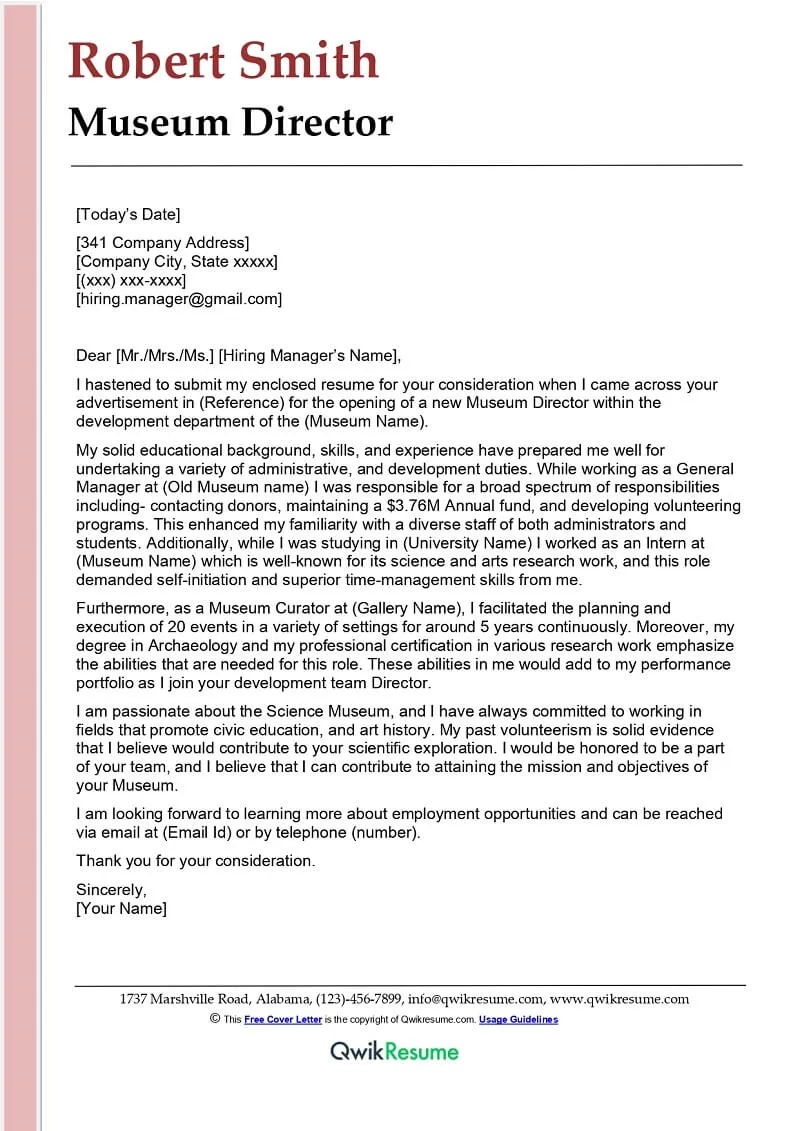Why Your Museum Job Cover Letter Matters
Your cover letter for a museum job is more than just a formality; it’s your initial opportunity to make a compelling impression and differentiate yourself from other applicants. In a competitive job market, particularly within the cultural sector, a well-crafted cover letter can be the key to unlocking an interview opportunity. It allows you to showcase your passion for the museum field, highlight relevant experiences and skills, and articulate your understanding of the specific museum and the role you are applying for. A strong cover letter is essentially your personal marketing document, designed to convince the hiring manager that you possess not only the qualifications but also the enthusiasm and personality that align with the museum’s mission and values. Neglecting this crucial document means missing a chance to stand out and potentially advancing your career in the museum sector.
Highlighting Relevant Museum Experience
When applying for museum jobs, detailing your experience directly related to the position is vital. This section should provide concrete examples of your accomplishments and responsibilities in previous roles. If you have experience in curatorial work, specify the exhibitions you have worked on, the size of the collections you managed, and any research contributions you made. For those in education roles, outline specific programs you developed or facilitated, highlighting the number of participants and positive outcomes. For those in administration roles, describe your experience with budgeting, grant writing, volunteer management, or any other relevant administrative tasks. Always quantify your achievements whenever possible, for instance, mentioning the number of visitors your programs served, the amount of funding you secured, or the efficiency improvements you implemented. Be precise and use action verbs to describe your tasks, making your experience vivid and relevant to the museum job.
Showcasing Skills Transferable to Museum Jobs
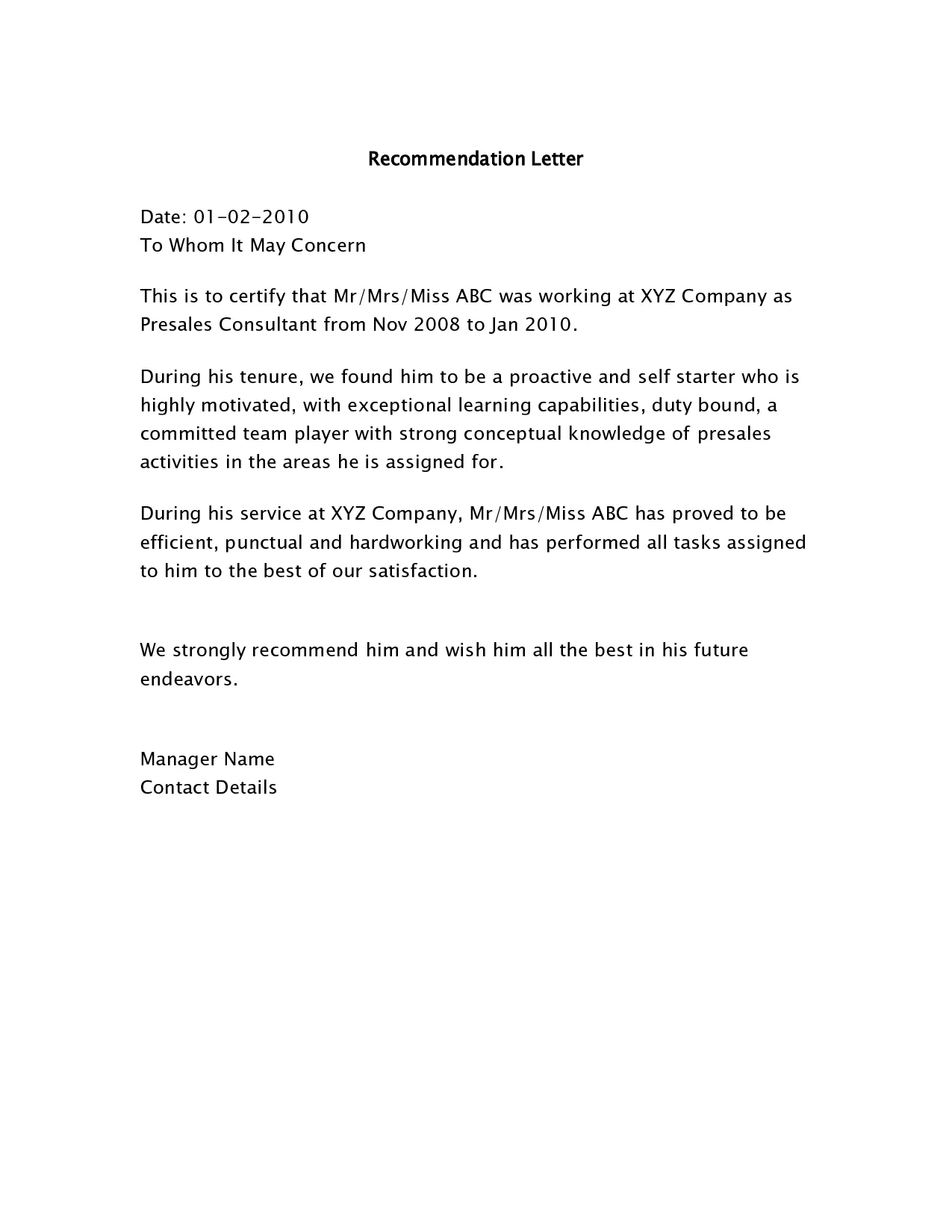
Even if you lack direct museum experience, emphasize transferable skills from other fields. Many skills gained in different professional settings are highly valuable in museums. For example, project management experience can be easily translated to exhibition planning or program coordination. Customer service skills are essential for visitor services and front-of-house positions. Strong communication skills, both written and verbal, are crucial for almost any role, including grant writing, public relations, and educational outreach. If you have experience in data analysis, highlight how you used it to improve operational efficiency or audience engagement. IT skills, such as experience with database management or digital content creation, are increasingly relevant. Tailor the skills you highlight to the specific requirements of the job, demonstrating how your background, though not directly museum-related, has equipped you to excel in the role.
Structuring Your Museum Job Cover Letter
Header and Contact Information
Start your cover letter with a professional header that includes your full name, address, phone number, and email address. It’s essential to ensure your contact information is current and easily accessible. Consider using a professional-looking font and formatting to make your header visually appealing and easy to read. If you’re applying for a specific position, include the date and the hiring manager’s name and title if known, and the museum’s address. If you don’t know the hiring manager’s name, use a generic salutation like “Dear Hiring Manager,” or, if possible, research the department head’s name on the museum’s website or LinkedIn. This personalization shows your attention to detail and genuine interest in the position.
The Opening Paragraph
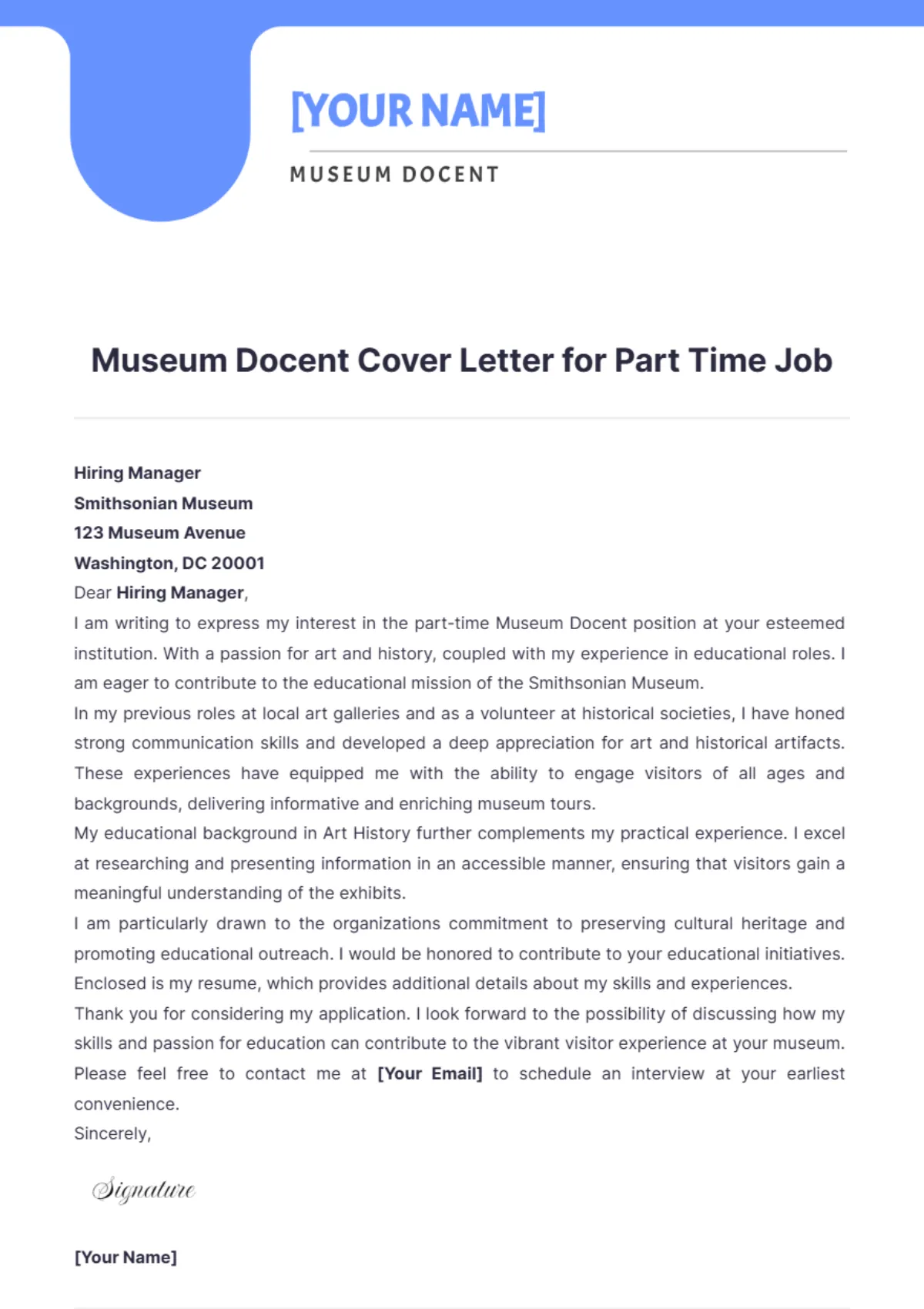
The opening paragraph should immediately grab the reader’s attention. State the specific position you’re applying for and where you saw the job posting. Express your strong interest in the position and the museum. Briefly mention something that sparked your interest in the museum or the role—this could be a specific exhibition, program, or the museum’s mission. Clearly articulate your understanding of the museum’s mission and values. End the first paragraph with a clear statement of your most relevant qualifications, hinting at the value you bring to the museum. The objective is to demonstrate your immediate understanding and enthusiasm for the position, compelling the hiring manager to keep reading. This paragraph sets the tone for the entire letter and should be concise and impactful.
Body Paragraphs Emphasizing Museum Job Skills
The body paragraphs should provide a more detailed account of your skills and experience. Break down your skills into different categories, aligning them with the job description’s requirements. Use each paragraph to expand on a key skill or achievement. For each point, provide concrete examples from your past experiences to show how you’ve demonstrated these skills. For instance, if the job requires strong organizational skills, describe a project you managed, detailing the planning, implementation, and outcomes. If the role involves communication, provide an example of a successful presentation or a grant proposal you wrote. Quantify your achievements whenever possible—for example, the number of people you trained, the budget you managed, or the efficiency improvements you achieved. Always connect your skills to the specific needs of the museum and the role you’re applying for, highlighting how you’ll contribute to its success.
Closing Your Museum Cover Letter
The closing paragraph should summarize your enthusiasm for the role and the museum. Reiterate your key qualifications and how they align with the museum’s needs. Express your strong interest in the opportunity to discuss your application further in an interview. Thank the hiring manager for their time and consideration. Use a professional closing such as “Sincerely” or “Best regards,” followed by your name. Make sure to proofread the entire cover letter before submitting it to ensure accuracy. Your closing paragraph is the final impression you make, so it’s essential to keep it positive, concise, and professional. It must be compelling and encourage the reader to take the next step—inviting you for an interview.
Tailoring Your Cover Letter for Each Museum Job
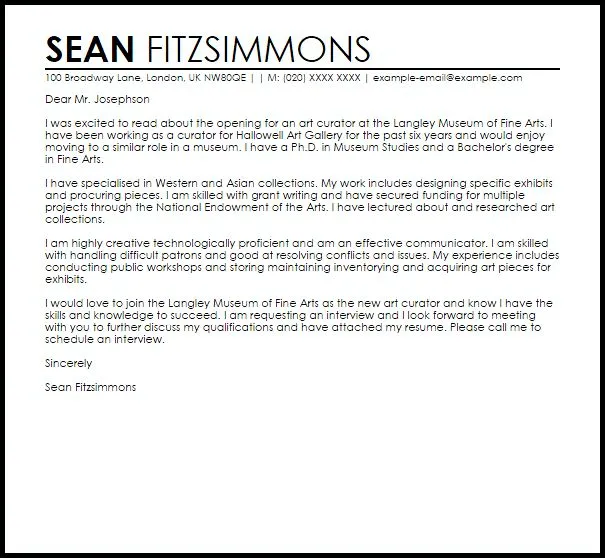
Researching the Museum and its Mission
Before submitting your cover letter, thorough research is vital. Start by visiting the museum’s website to understand its mission, values, and current initiatives. Explore recent exhibitions, programs, and educational offerings to get a feel for the museum’s current focus and strategic direction. Look for press releases, social media activity, and any information that provides insight into the museum’s public image and priorities. Understanding the museum’s mission and values allows you to tailor your cover letter to highlight how your skills and experience align with their specific goals. By demonstrating your genuine interest and knowledge of the museum, you show the hiring manager that you’ve invested time and effort in the application. This personalized approach dramatically increases your chances of standing out from generic applicants.
Matching Skills and Experience to Job Requirements
Carefully review the job description to identify the required skills, qualifications, and experiences. Make a list of the key requirements and, as you draft your cover letter, address each of these. Use the job description’s language and keywords whenever possible to demonstrate that you meet the employer’s needs. Provide concrete examples of how you’ve successfully used each skill or experience in previous roles. If the job description mentions a specific software or technology, and you have experience with it, be sure to highlight that. If there are any specific projects or initiatives mentioned in the job description, try to relate your experience to these. Tailoring your cover letter shows the hiring manager that you are a good fit for the role and have carefully considered the position’s requirements.
Proofreading and Editing Your Cover Letter
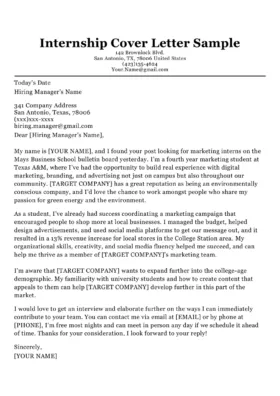
Using Professional Language and Tone
Maintain a professional tone throughout your cover letter. Avoid overly casual language, slang, or jargon that might not be appropriate for a formal application. Use a respectful and formal tone, addressing the hiring manager correctly and using polite language. Ensure your writing is clear, concise, and easy to understand. Avoid complex sentences or overly flowery language. Be sure to avoid any negative language or criticism. Always focus on the positive aspects of your experiences and how you can contribute to the museum. The use of proper grammar, punctuation, and spelling is crucial. A well-written, professional cover letter reflects your attention to detail and your respect for the hiring process.
Checking for Grammatical Errors and Typos
Carefully proofread your cover letter for any grammatical errors, typos, or spelling mistakes. These errors can create a negative impression, suggesting carelessness or a lack of attention to detail. Use a grammar checker and spell-checker to catch potential issues. Read the letter aloud to identify any awkward phrasing or sentences that might need revision. Consider asking a friend, family member, or career counselor to review your cover letter. They may catch errors that you have missed. It’s essential to present a polished, error-free document, demonstrating professionalism and respect for the application process. Proofreading and editing are essential to creating a positive first impression and increasing your chances of securing an interview.
Following Up After Submitting Your Cover Letter
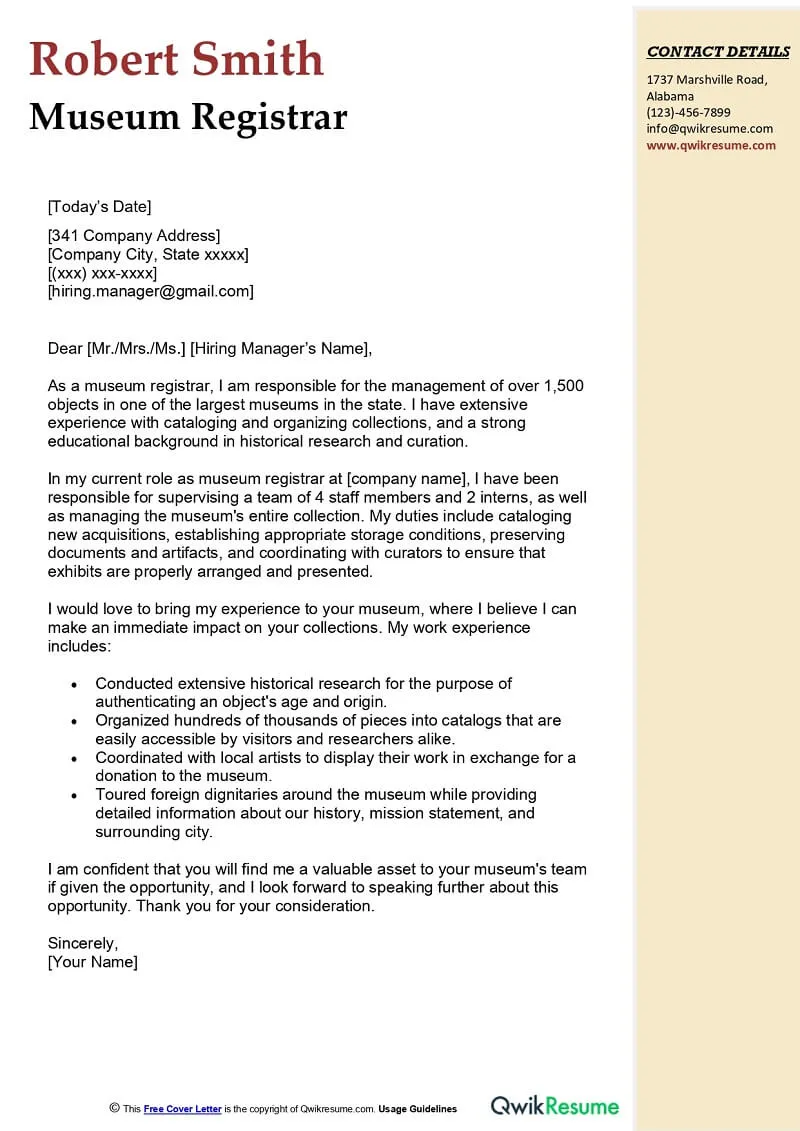
Sending a Thank-You Note
If you’ve interviewed for a museum job, send a thank-you note to the interviewer within 24 hours. This is a professional courtesy that reinforces your interest in the position. You should reiterate your thanks for their time and the opportunity to discuss the role. Briefly mention a specific topic or detail discussed during the interview to remind the interviewer of your conversation. Reiterate your enthusiasm for the position and your belief that you are the right fit for the job. Confirm your interest in the position and express your appreciation for their consideration. A thank-you note shows that you are attentive, professional, and genuinely interested in the position.
Preparing for Potential Interviews
If you’re invited for an interview, it is essential to thoroughly prepare in advance. Research the museum and the role to anticipate potential questions. Prepare answers to common interview questions, such as “Tell me about yourself” and “Why are you interested in this position?” Review your cover letter and resume, preparing to elaborate on your experiences and skills. Prepare questions to ask the interviewer. During the interview, dress professionally, maintain good eye contact, and be enthusiastic. Be prepared to discuss how your skills and experience align with the museum’s needs and mission. After the interview, make sure to send a thank-you note to the interviewer, reemphasizing your interest and gratitude. Careful preparation is critical to making a positive impression and increasing your chances of getting the job.
